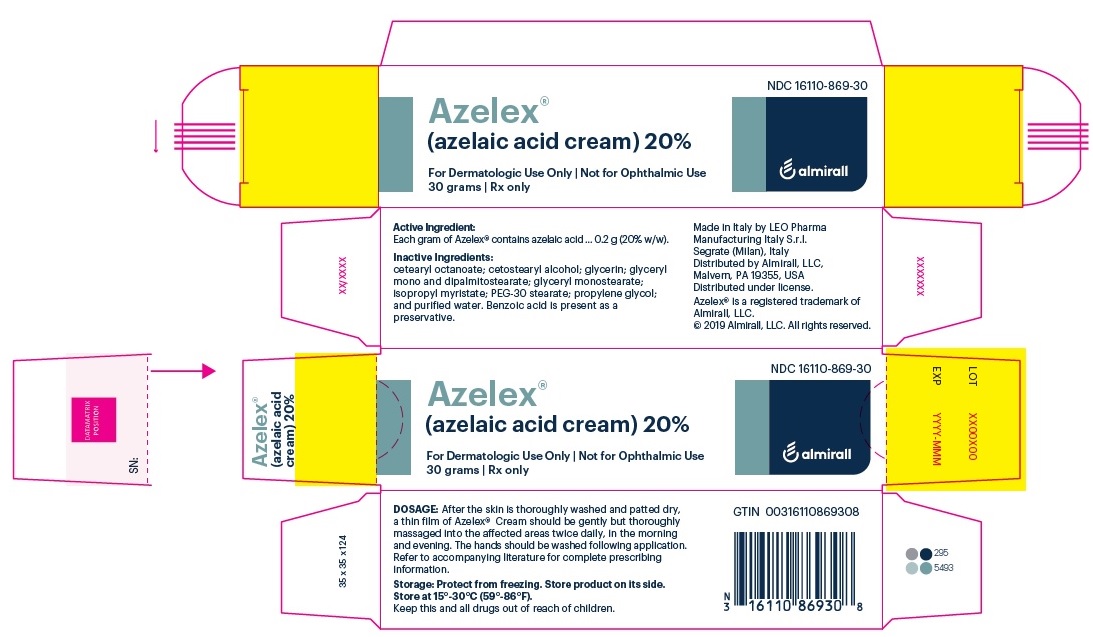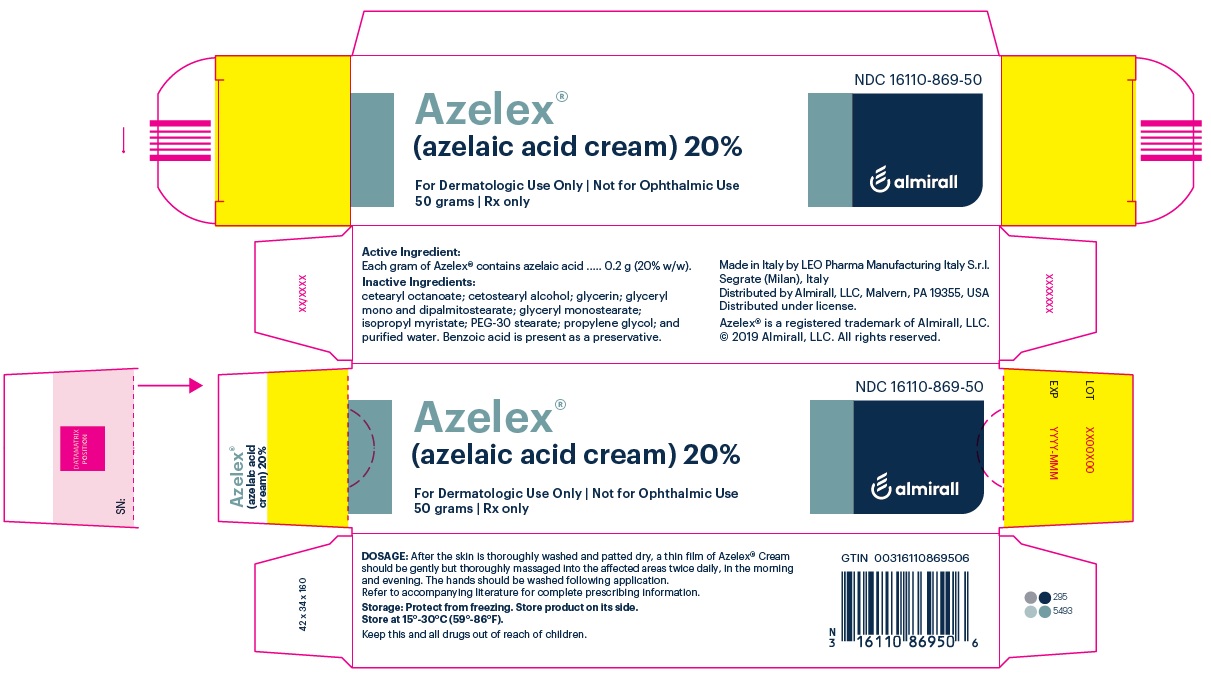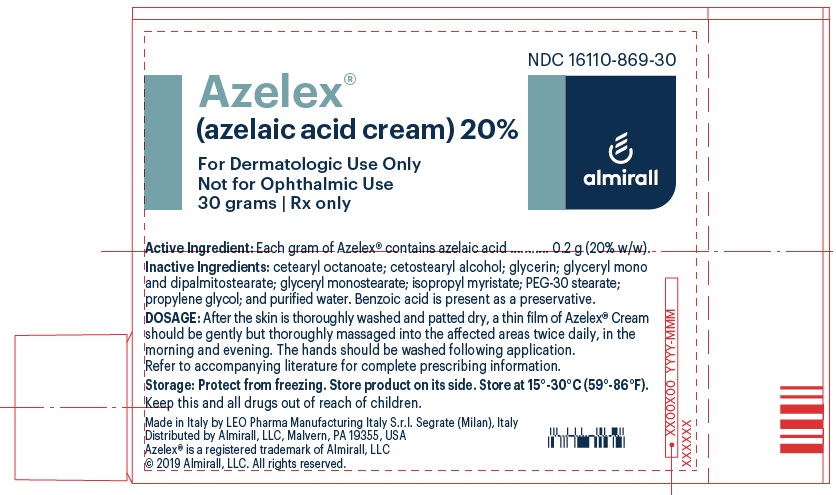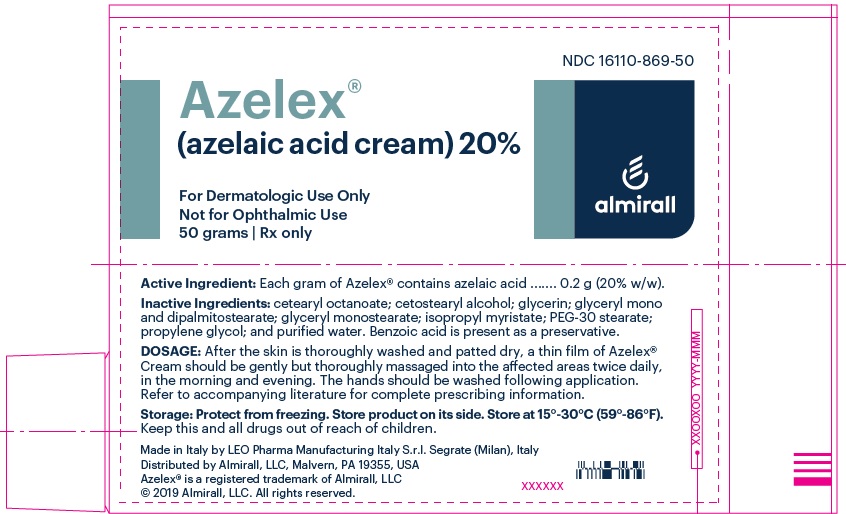DESCRIPTION
AZELEX® (azelaic acid cream) 20% contains azelaic acid, a naturally occurring saturated dicarboxylic acid.
Structural Formula: HOOC-(CH2)7-COOH
Chemical Name: 1,7-heptanedicarboxylic acid
Empirical Formula: C9H16O4
Molecular Weight: 188.22
CLINICAL PHARMACOLOGY
The exact mechanism of action of azelaic acid is not known. The following in vitro data are available, but their clinical significance is unknown. Azelaic acid has been shown to possess antimicrobial activity against Propionibacterium acnes and Staphylococcus epidermidis. The antimicrobial action may be attributable to inhibition of microbial cellular protein synthesis.
A normalization of keratinization leading to an anticomedonal effect of azelaic acid may also contribute to its clinical activity. Electron microscopic and immunohistochemical evaluation of skin biopsies from human subjects treated with AZELEX® cream demonstrated a reduction in the thickness of the stratum corneum, a reduction in number and size of keratohyalin granules, and a reduction in the amount and distribution of filaggrin (a protein component of keratohyalin) in epidermal layers. This is suggestive of the ability to decrease microcomedo formation.
Pharmacokinetics
Following a single application of AZELEX® cream to human skin in vitro, azelaic acid penetrates into the stratum corneum (approximately 3 to 5% of the applied dose) and other viable skin layers (up to 10% of the dose is found in the epidermis and dermis). Negligible cutaneous metabolism occurs after topical application. Approximately 4% of the topically applied azelaic acid is systemically absorbed. Azelaic acid is mainly excreted unchanged in the urine but undergoes some β-oxidation to shorter chain dicarboxylic acids. The observed half-lives in healthy subjects are approximately 45 minutes after oral dosing and 12 hours after topical dosing, indicating percutaneous absorption rate-limited kinetics.
Azelaic acid is a dietary constituent (whole grain cereals and animal products), and can be formed endogenously from longer-chain dicarboxylic acids, metabolism of oleic acid, and ψ-oxidation of monocarboxylic acids. Endogenous plasma concentration (20 to 80 ng/mL) and daily urinary excretion (4 to 28 mg) of azelaic acid are highly dependent on dietary intake. After topical treatment with AZELEX® cream in humans, plasma concentration and urinary excretion of azelaic acid are not significantly different from baseline levels.
INDICATIONS AND USAGE
AZELEX® cream is indicated for the topical treatment of mild-to-moderate inflammatory acne vulgaris.
CONTRAINDICATIONS
AZELEX® cream is contraindicated in individuals who have shown hypersensitivity to any of its components.
WARNINGS
AZELEX® cream is for dermatologic use only and not for ophthalmic use.
There have been isolated reports of hypopigmentation after use of azelaic acid. Since azelaic acid has not been well studied in patients with dark complexions, these patients should be monitored for early signs of hypopigmentation.
PRECAUTIONS
General
If sensitivity or severe irritation develop with the use of AZELEX® cream, treatment should be discontinued and appropriate therapy instituted.
Information for Patients
Patients should be told:
- To use AZELEX® cream for the full prescribed treatment period.
- To avoid the use of occlusive dressings or wrappings.
- To keep AZELEX® cream away from the mouth, eyes and other mucous membranes. If it does come in contact with the eyes, they should wash their eyes with large amounts of water and consult a physician if eye irritation persists.
- If they have dark complexions, to report abnormal changes in skin color to their physician.
- Due in part to the low pH of azelaic acid, temporary skin irritation (pruritus, burning, or stinging) may occur when AZELEX® cream is applied to broken or inflamed skin, usually at the start of treatment. However, this irritation commonly subsides if treatment is continued. If it continues, AZELEX
Carcinogenesis, Mutagenesis, Impairment of Fertility
Azelaic acid is a human dietary component of a simple molecular structure that does not suggest carcinogenic potential, and it does not belong to a class of drugs for which there is a concern about carcinogenicity. Therefore, animal studies to evaluate carcinogenic potential with AZELEX® cream were not deemed necessary. In a battery of tests (Ames assay, HGPRT test in Chinese hamster ovary cells, human lymphocyte test, dominant lethal assay in mice), azelaic acid was found to be nonmutagenic. Animal studies have shown no adverse effects on fertility.
Pregnancy
Teratogenic Effects
Embryotoxic effects were observed in Segment I and Segment II oral studies with rats receiving 2500 mg/kg/day of azelaic acid. Similar effects were observed in Segment II studies in rabbits given 150 to 500 mg/kg/day and in monkeys given 500 mg/kg/day. The doses at which these effects were noted were all within toxic dose ranges for the dams. No teratogenic effects were observed. There are, however, no adequate and well-controlled studies in pregnant women. Because animal reproduction studies are not always predictive of human response, this drug should be used during pregnancy only if clearly needed.
Nursing Mothers
Equilibrium dialysis was used to assess human milk partitioning in vitro. At an azelaic acid concentration of 25 mcg/mL, the milk/plasma distribution coefficient was 0.7 and the milk/buffer distribution was 1.0, indicating that passage of drug into maternal milk may occur. Since less than 4% of a topically applied dose is systemically absorbed, the uptake of azelaic acid into maternal milk is not expected to cause a significant change from baseline azelaic acid levels in the milk. However, caution should be exercised when AZELEX® cream is administered to a nursing mother.
ADVERSE REACTIONS
During U.S. clinical trials with AZELEX® cream, adverse reactions were generally mild and transient in nature. The most common adverse reactions occurring in approximately 1-5% of patients were pruritus, burning, stinging and tingling. Other adverse reactions such as erythema, dryness, rash, peeling, irritation, dermatitis, and contact dermatitis were reported in less than 1% of subjects. There is the potential for experiencing allergic reactions with use of AZELEX® cream.
In patients using azelaic acid formulations, the following additional adverse experiences have been reported rarely: worsening of asthma, vitiligo depigmentation, small depigmented spots, hypertrichosis, reddening (signs of keratosis pilaris), and exacerbation of recurrent herpes labialis.
DOSAGE AND ADMINISTRATION
After the skin is thoroughly washed and patted dry, a thin film of AZELEX® cream should be gently but thoroughly massaged into the affected areas twice daily, in the morning and evening. The hands should be washed following application. The duration of use of AZELEX® cream can vary from person to person and depends on the severity of the acne. Improvement of the condition occurs in the majority of patients with inflammatory lesions within four weeks.
HOW SUPPLIED
AZELEX® cream is supplied in a closed orifice tube with a white, spiked screwcap in the following sizes:
30 g - NDC 16110-869-30
50 g - NDC 16110-869-50
Storage: Protect from freezing. Store product on its side. Store at 15°-30° C (59°-86° F).
Revised: 02/2024
Distributed by Almirall, LLC, Malvern, PA 19355, U.S.A.
© 2019 Almirall. All right reserved.
® marks owned by Almirall, LLC.
Made in Italy by LEO Pharma Manufacturing Italy S.r.l., Segrate (Milan), Italy



